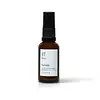What's inside
What's inside
 Key Ingredients
Key Ingredients

 Benefits
Benefits

 Concerns
Concerns

 Ingredients Side-by-side
Ingredients Side-by-side

Zinc Oxide 17.5%
Cosmetic ColorantWater
Skin ConditioningCaprylic/Capric Triglyceride
MaskingGlycerin
HumectantMethyl Dihydroabietate
Cetearyl Alcohol
EmollientCetyl Palmitate
EmollientCoco-Glucoside
CleansingCaprylyl/Capryl Glucoside
CleansingSorbitan Palmitate
EmulsifyingSorbitan Olivate
EmulsifyingButyrospermum Parkii Nut Extract
EmollientEthyl Ferulate
AntioxidantBisabolol
MaskingAllantoin
Skin ConditioningHydrolyzed Jojoba Esters
Skin ConditioningAcacia Senegal Gum
MaskingPolyhydroxystearic Acid
EmulsifyingPolyglyceryl-3 Polyricinoleate
EmulsifyingIsostearic Acid
CleansingLecithin
EmollientTocopheryl Acetate
AntioxidantTetrahexyldecyl Ascorbate
AntioxidantDecapeptide-52
Skin ConditioningOryza Sativa Starch
AbsorbentCamellia Sinensis Leaf Extract
AntimicrobialEuterpe Oleracea Fruit Extract
Caesalpinia Spinosa Fruit Pod Extract
Helianthus Annuus Sprout Extract
Skin ConditioningCaprylyl Glycol
EmollientEthylhexylglycerin
Skin ConditioningHexylene Glycol
EmulsifyingXanthan Gum
EmulsifyingSodium Phytate
Propylene Glycol
HumectantPhenoxyethanol
PreservativeSodium Benzoate
MaskingPotassium Sorbate
PreservativeZinc Oxide 17.5%, Water, Caprylic/Capric Triglyceride, Glycerin, Methyl Dihydroabietate, Cetearyl Alcohol, Cetyl Palmitate, Coco-Glucoside, Caprylyl/Capryl Glucoside, Sorbitan Palmitate, Sorbitan Olivate, Butyrospermum Parkii Nut Extract, Ethyl Ferulate, Bisabolol, Allantoin, Hydrolyzed Jojoba Esters, Acacia Senegal Gum, Polyhydroxystearic Acid, Polyglyceryl-3 Polyricinoleate, Isostearic Acid, Lecithin, Tocopheryl Acetate, Tetrahexyldecyl Ascorbate, Decapeptide-52, Oryza Sativa Starch, Camellia Sinensis Leaf Extract, Euterpe Oleracea Fruit Extract, Caesalpinia Spinosa Fruit Pod Extract, Helianthus Annuus Sprout Extract, Caprylyl Glycol, Ethylhexylglycerin, Hexylene Glycol, Xanthan Gum, Sodium Phytate, Propylene Glycol, Phenoxyethanol, Sodium Benzoate, Potassium Sorbate
Water
Skin ConditioningGlycerin
HumectantCyclopentasiloxane
EmollientCaprylic/Capric Triglyceride
MaskingDimethicone
EmollientGlyceryl Stearate
EmollientCeteareth-20
CleansingCetearyl Alcohol
EmollientGlucosamine
Silver
Cosmetic ColorantLactic Acid
BufferingPEG-100 Stearate
Triethanolamine 1%
BufferingPhenoxyethanol
PreservativeButyrospermum Parkii Butter
Skin ConditioningEthylhexylglycerin
Skin ConditioningChitosan
Limonene
PerfumingAllantoin
Skin ConditioningCitrus Tangerina Peel Oil
MaskingCitrus Aurantium Bergamia Peel Oil
Citrus Grandis Peel Oil
MaskingCitrus Aurantium Dulcis Peel Oil
MaskingCitral
PerfumingLinalool
PerfumingSilver Chloride
PreservativeCitronellol
PerfumingGeraniol
PerfumingWater, Glycerin, Cyclopentasiloxane, Caprylic/Capric Triglyceride, Dimethicone, Glyceryl Stearate, Ceteareth-20, Cetearyl Alcohol, Glucosamine, Silver, Lactic Acid, PEG-100 Stearate, Triethanolamine 1%, Phenoxyethanol, Butyrospermum Parkii Butter, Ethylhexylglycerin, Chitosan, Limonene, Allantoin, Citrus Tangerina Peel Oil, Citrus Aurantium Bergamia Peel Oil, Citrus Grandis Peel Oil, Citrus Aurantium Dulcis Peel Oil, Citral, Linalool, Silver Chloride, Citronellol, Geraniol
Ingredients Explained
These ingredients are found in both products.
Ingredients higher up in an ingredient list are typically present in a larger amount.
Allantoin is a soothing ingredient known for its protective and moisturizingg properties. Because of this, it is often added to products with strong active ingredients.
Studies show higher concentrations of this ingredient can promote wound healing.
Though it can be derived from the comfrey plant, allantoin is produced synthetically for cosmetic products to ensure purity.
Learn more about AllantoinThis ingredient is an emollient, solvent, and texture enhancer. It is considered a skin-softener by helping the skin prevent moisture loss.
It helps thicken a product's formula and makes it easier to spread by dissolving clumping compounds.
Caprylic Triglyceride is made by combining glycerin with coconut oil, forming a clear liquid.
While there is an assumption Caprylic Triglyceride can clog pores due to it being derived from coconut oil, there is no research supporting this.
Learn more about Caprylic/Capric TriglycerideCetearyl alcohol is a mixture of two fatty alcohols: cetyl alcohol and stearyl alcohol. It is mainly used as an emulsifier. Emulsifiers help prevent the separation of oils and products. Due to its composition, it can also be used to thicken a product or help create foam.
Cetearyl alcohol is an emollient. Emollients help soothe and hydrate the skin by trapping moisture.
Studies show Cetearyl alcohol is non-toxic and non-irritating. The FDA allows products labeled "alcohol-free" to have fatty alcohols.
This ingredient is usually derived from plant oils such as palm, vegetable, or coconut oils. There is debate on whether this ingredient will cause acne.
Due to the fatty acid base, this ingredient may not be Malassezia folliculitis safe.
Learn more about Cetearyl AlcoholEthylhexylglycerin (we can't pronounce this either) is commonly used as a preservative and skin softener. It is derived from glyceryl.
You might see Ethylhexylglycerin often paired with other preservatives such as phenoxyethanol. Ethylhexylglycerin has been found to increase the effectiveness of these other preservatives.
Glycerin is already naturally found in your skin. It helps moisturize and protect your skin.
A study from 2016 found glycerin to be more effective as a humectant than AHAs and hyaluronic acid.
As a humectant, it helps the skin stay hydrated by pulling moisture to your skin. The low molecular weight of glycerin allows it to pull moisture into the deeper layers of your skin.
Hydrated skin improves your skin barrier; Your skin barrier helps protect against irritants and bacteria.
Glycerin has also been found to have antimicrobial and antiviral properties. Due to these properties, glycerin is often used in wound and burn treatments.
In cosmetics, glycerin is usually derived from plants such as soybean or palm. However, it can also be sourced from animals, such as tallow or animal fat.
This ingredient is organic, colorless, odorless, and non-toxic.
Glycerin is the name for this ingredient in American English. British English uses Glycerol/Glycerine.
Learn more about GlycerinPhenoxyethanol is a preservative that has germicide, antimicrobial, and aromatic properties. Studies show that phenoxyethanol can prevent microbial growth. By itself, it has a scent that is similar to that of a rose.
It's often used in formulations along with Caprylyl Glycol to preserve the shelf life of products.
Water. It's the most common cosmetic ingredient of all. You'll usually see it at the top of ingredient lists, meaning that it makes up the largest part of the product.
So why is it so popular? Water most often acts as a solvent - this means that it helps dissolve other ingredients into the formulation.
You'll also recognize water as that liquid we all need to stay alive. If you see this, drink a glass of water. Stay hydrated!
Learn more about Water